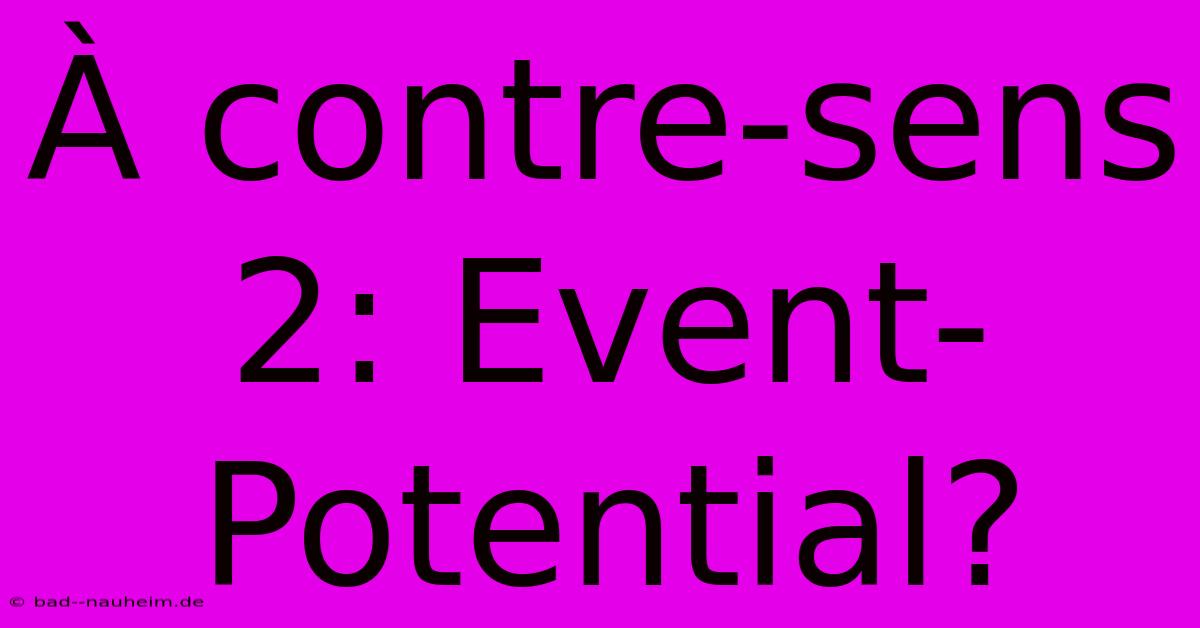À Contre-sens 2: Event-Potential?

Discover more detailed and exciting information on our website. Click the link below to start your adventure: Visit My Website. Don't miss out!
Table of Contents
À Contre-Sens 2: Event-Potential? Unveiling the Power of Unexpected Narratives
The original À Contre-Sens (Against the Grain) challenged conventional storytelling. Its sequel, implicitly titled À Contre-Sens 2, pushes this further, exploring the captivating potential of narratives that deliberately subvert expectations. This isn't just about plot twists; it's about harnessing the event-potential inherent in unexpected juxtapositions, character development, and thematic shifts.
What is Event-Potential?
Event-potential, in narrative terms, refers to the inherent capacity of a story element – be it a character action, a plot development, or a thematic revelation – to significantly alter the trajectory of the narrative. It's about creating moments that resonate deeply, forcing the audience to reassess their understanding of the story and its characters. A high event-potential signifies a moment with the power to drastically change the story's direction, emotional impact, or thematic resonance.
Harnessing the Power of the Unexpected in À Contre-Sens 2
À Contre-Sens 2 leverages event-potential through several key strategies:
-
Subverting Genre Conventions: The sequel could intentionally defy genre expectations. If the first installment was a straightforward thriller, À Contre-Sens 2 might incorporate elements of surrealism or dark comedy, creating jarring yet compelling shifts in tone and atmosphere. This unexpected genre-bending significantly increases event-potential.
-
Unreliable Narration and Shifting Perspectives: Introducing an unreliable narrator or multiple, conflicting perspectives can dramatically increase event-potential. The audience's understanding of events is constantly challenged, leading to a more engaging and thought-provoking experience. This technique forces a re-evaluation of previously held assumptions, making even seemingly minor details significant.
-
Character Transformations and Unexpected Alliances: Characters who initially seem antagonistic might unexpectedly forge alliances, or a protagonist might undergo a complete moral transformation. Such unexpected shifts create high event-potential, forcing the audience to reconsider their perceptions of the characters and their motivations. This requires careful planning, ensuring these shifts feel organic and well-justified.
-
Thematic Dissonance and Irony: Introducing thematic dissonance – a stark contrast between the narrative's surface and its underlying themes – can also enhance event-potential. A story seemingly about revenge might subtly explore themes of forgiveness or redemption, creating a powerful and unexpected emotional impact. Irony, when employed skillfully, can further heighten this effect.
Building Tension and Engagement Through Event-Potential
The skillful use of event-potential is not simply about shocking the audience; it's about creating a compelling narrative arc that keeps the audience engaged and invested. Each unexpected turn should feel earned, organically emerging from the narrative's structure and character development. Effective pacing is crucial: too many unexpected events can overwhelm the audience, while too few can make the narrative predictable and dull.
Conclusion: The Art of the Unexpected
À Contre-Sens 2, by embracing the principles of event-potential, can achieve a higher level of narrative engagement. The key lies in a carefully constructed narrative that uses unexpected elements to challenge expectations, deepen emotional resonance, and create a truly unforgettable storytelling experience. The result? A story that lingers in the mind long after the final page is turned. The challenge lies in skillfully balancing the unexpected with narrative coherence, ensuring that every event contributes to a meaningful and compelling whole.

Thank you for visiting our website wich cover about À Contre-sens 2: Event-Potential?. We hope the information provided has been useful to you. Feel free to contact us if you have any questions or need further assistance. See you next time and dont miss to bookmark.
Also read the following articles
| Article Title | Date |
|---|---|
| Schweizer Rauben Bormio Doppelsieg | Dec 28, 2024 |
| Leipzig Sichert Olmo Klage Zurueckgewiesen | Dec 28, 2024 |
| Semmering Starke Stimmung Beim Sport | Dec 28, 2024 |
| Olmo Verpasst Barca Wechsel Im Januar | Dec 28, 2024 |
| Darts Pietreczkos Pikachu Moment | Dec 28, 2024 |
